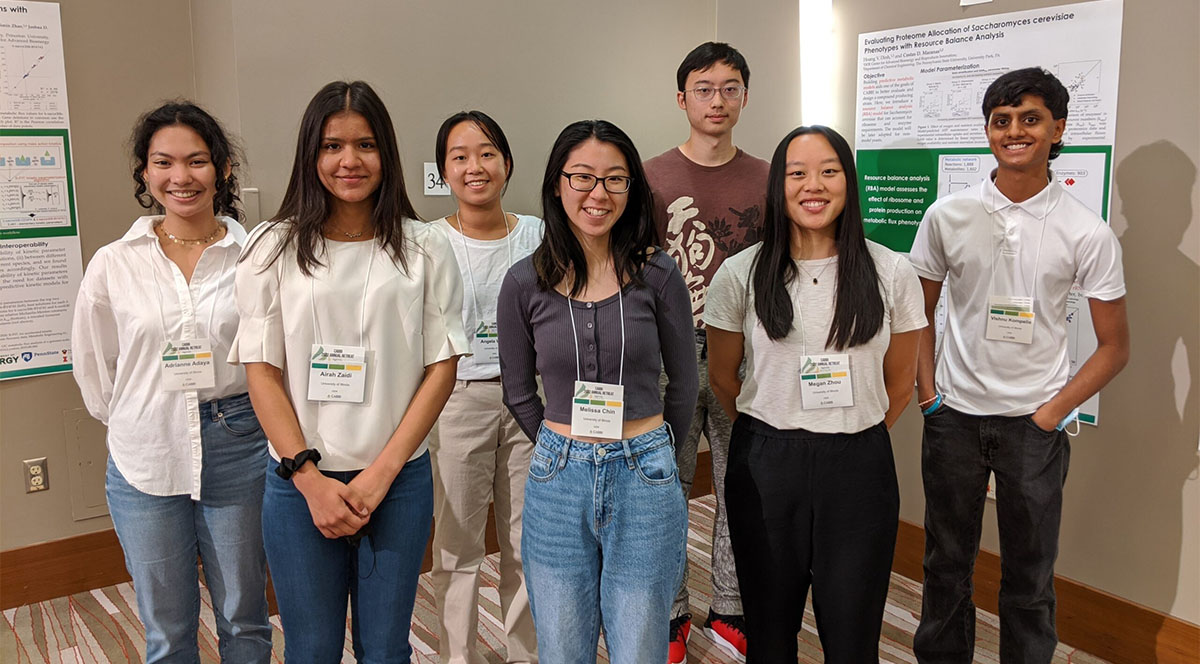Update: The Illinois team’s “Curli Capture” was awarded a bronze medal at the International Genetically Engineered Machine (iGEM) 2022 competition. The seven-member student team worked to design proteins that can help remediate waterways suffering from the ill effects of nitrate runoff.
Modern agriculture has become a major source of pollution in many forms. One facet of this pollution is nitrate runoff. Nitrates are used in fertilizers as a source of nitrogen, which is essential for plant growth. Although these fertilizers help improve crop yields, excess nitrates often end up in waterways, where they can cause harmful algal blooms and other ecological problems.

Perhaps the most well-known example of the ill effects of nutrient runoff is the Gulf of Mexico dead zone. Excess fertilizer in the Mississippi River watershed washes downstream and into the gulf. The abundance of nutrients fuels the rapid growth of algae, which depletes oxygen availability. This is known as hypoxia — oxygen levels drop so low that they can no longer sustain marine life.
Closer to home in Illinois, Lake Decatur supplies 39.4 million gallons of water every day to 87,000 people in surrounding communities. However, due to agricultural runoff, high concentrations of nitrate can be found in the lake, creating unsafe drinking water conditions and disruptions in the aquatic ecosystem by overstimulating plant growth.
Enter the 2022 University of Illinois iGEM team, who kicked off their research with a single guiding question: How can nitrate runoff be remediated to improve the ecological health of our waterways?
This team of seven U of I undergraduates and their graduate student and faculty mentors from the University of Illinois Urbana-Champaign was sponsored by the Carl R. Woese Institute for Genomic Biology (IGB) and CABBI to take part in the annual International Genetically Engineered Machine (iGEM) Competition in Summer 2022.
Their project, called Curli Capture, offers a possible solution to our nitrate pollution problem. Inspired by previous synthetic biology work on engineering catalytic biofilms to capture heavy metals, the iGEM team planned to engineer a biofilm that can capture excess nitrate in bodies of water — a solution with the potential to be cost-effective and environmentally friendly.
By fusing a nitrate-binding protein to curli biofilm, a nitrate-capturing system can be created. Curli biofilm is a collection of fibrous proteins woven together like a scaffolding, which can be used to support nitrate-binding proteins that bind to and capture nitrate. The curli biofilm and nitrate-binding protein can be permanently attached to each other via a synthetic biology technology called the SpyTag/SpyCatcher system.
To actualize this Curli Capture system, the Illinois iGEM team engineered bacteria that could produce the necessary components. This was achieved by inserting specially crafted plasmids into E. coli. Plasmids are small circular DNA molecules that can be used to introduce new genes into an organism. The first plasmid included the genetic sequence that codes for the curli protein and the SpyTag sequence, which codes for a short chain of amino acids. The second plasmid contained the sequence that codes for the nitrate-binding protein and the SpyCatcher sequence, which codes for the SpyCatcher protein that will bond to the SpyTag protein when the two come into contact. The interaction between SpyCatcher and Spytag will securely attach the nitrate-binding protein to the curli biofilm.
Though the team was unable to fully characterize and recombine their engineered strains, they remain hopeful that such a system could be deployed in the future as a means of reducing nitrate pollution in agricultural runoff. Additionally, they noted that by fusing different functional proteins to curli biofilms, systems similar to Curli Capture could be engineered for the remediation of other pollutants as well.
The iGEM team consists of Adrianne Adaya, junior in Chemical Engineering; Airah Zaidi, junior in Chemical & Biomolecular Engineering; Vishnu Kompella, sophomore in Physics; Angela Wang, junior in Biochemistry; Megan Zhou, junior in Bioengineering; Melissa Chin, junior in Chemical Engineering; and Luren Wang, undergrad in Mechanical Engineering. For many, this was their first experience designing a synthetic biology research project. The students are optimistic that the skills they’ve built up from this project will help them reach new heights as they continue to pursue their research interests.
On Oct. 26-28, the Illinois iGEM team will present its work remotely at the 2022 iGEM Grand Jamboree, a combined remote/in-person celebration of the research accomplishments of over 350 iGEM teams from around the world.
Read more about Curli Capture and the team on its webpage >>>

